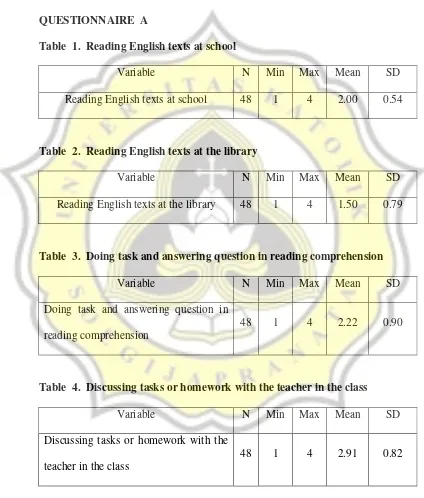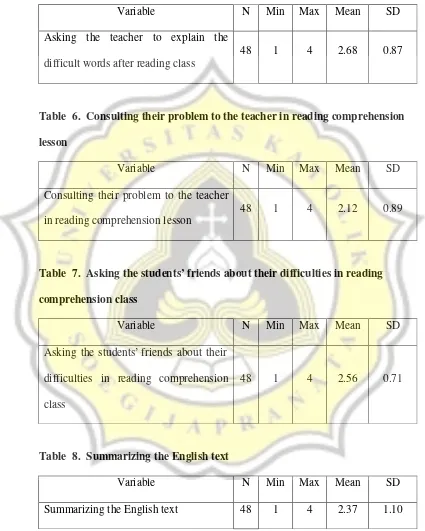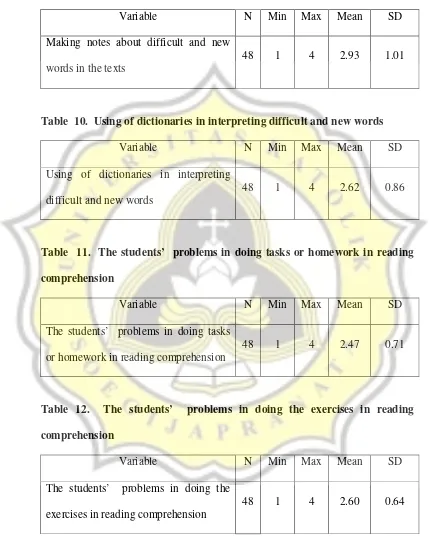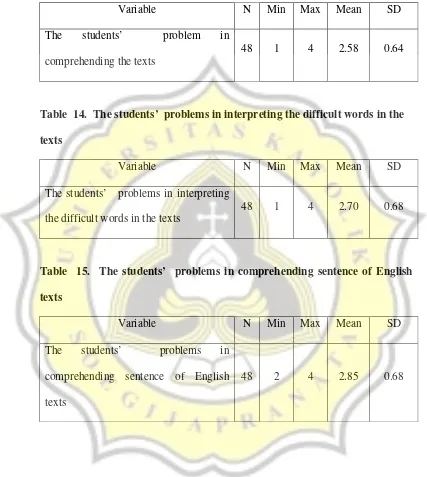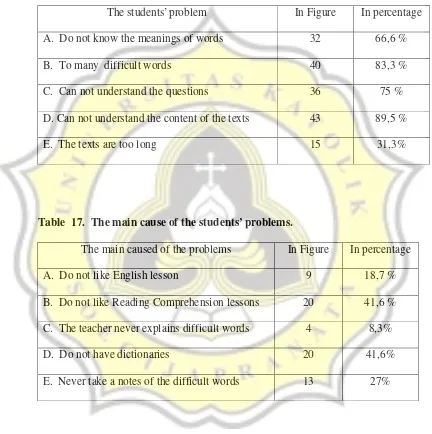APPENDIX 1
DAFTAR ANGKET UNTUK PARA MURID
ANGKET A
Petunjuk :
1. Bacalah terlebih dahulu setiap pertanyaan dengan teliti sebelum menjawabnya.
2. Setiap pertanyaan hanya boleh diisi dengan satu jawaban. Cara menjawabnya yaitu dengan melingkari huruf yang ada di depan pilihan jawaban.
3. Jawablah setiap pertanyaan dengan jujur sesuai dengan keadaan anda yang sebenarnya, karena angket ini tidak akan mempengaruhi nilai pelajaran anda.
1. Apakah kamu sering membaca bacaan bahasa Inggris di sekolah ? 1 = Tidak pernah
2 = Kadang – kadang 3 = Sering
4 = Selalu
2. Apakah kamu sering pergi ke perpustakaan untuk membaca bacaan bahasa Inggris?
1 = Tidak pernah 2 = Kadang – kadang 3 = Sering
3. Apakah kamu sering mengerjakan tugas dan menjawab pertanyaan di dalam pelajaran pemahaman bahasa Inggris ?
1 = Tidak pernah 2 = Kadang – kadang 3 = Sering
4 = Selalu
4. Apakah kamu sering membahas tugas dan pekerjaan rumah dengan gurumu dikelas ?
1 = Tidak pernah 2 = Kadang – kadang 3 = Sering
4 = Selalu
5. Apakah kamu sering meminta gurumu untuk menjelaskan kata – kata yang tidak kamu mengerti setelah kamu selesai membaca ?
1 = Tidak pernah 2 = Kadang – kadang 3 = Sering
4 = Selalu
6. Apakah kamu sering bertanya kepada gurumu jika kurang memahami isi bacaan bahasa Inggris ?
1 = Tidak pernah 2 = Kadang – kadang 3 = Sering
7. Apakah kamu sering bertanya kepada temanmu apabila kesulitan dalam menjawab pertanyaan reading comprehension (pemahaman bacaan bahasa Inggris) ?
1 = Tidak pernah 2 = Kadang – kadang 3 = Sering
4 = Selalu
8. Apakah kamu sering merangkum isi dari suatu bacaan bahasa Inggris ? 1 = Tidak pernah
2 = Kadang – kadang 3 = Sering
4 = Selalu
9. Apakah kamu sering mencatat kata – kata sukar atau baru dalam bacaan bahasa Inggris ?
1 = Tidak pernah 2 = Kadang – kadang 3 = Sering
4 = Selalu
10. Apakah kamu sering memakai kamus dalam mengartikan kata – kata sukar atau baru dalam bacaan bahasa Inggris ?
1 = Tidak pernah 2 = Kadang – kadang 3 = Sering
11. Apakah kamu sering mengalami kesulitan dalam mengerjakan pekerjaan rumah ataupun tugas tentang reading comprehension (pemahaman bacaan bahasa Inggris) ?
1 = Tidak pernah 2 = Kadang – kadang 3 = Sering
4 = Selalu
12. Apakah kamu sering mengalami kesulitan dalam mengerjakan soal – soal latihan tentang reading comprehension (pemahaman bacaan bahasa Inggris) ?
1 = Tidak pernah 2 = Kadang – kadang 3 = Sering
4 = Selalu
13. Apakah kamu sering mengalami kesulitan dalam memahami suatu bacaan bahasa Inggris ?
1 = Tidak pernah 2 = Kadang – kadang 3 = Sering
4 = Selalu
14. Apakah kamu sering mengalami kesulitan mengartikan kata – kata sukar dalam bacaan bahasa Inggris ?
1 = Tidak pernah 2 = Kadang – kadang 3 = Sering
15. Apakah kamu sering mengalami kesulitan dalam memahami kalimat dalam bacaan bahasa Inggris ?
1 = Tidak pernah 2 = Kadang – kadang 3 = Sering
ANGKET B
Lingkari jawaban yang kamu pilih ( jawaban bisa lebih dari satu )
1. Apakah masalah yang kamu hadapi dalam menjawab soal – soal reading comprehension ?
a. Tidak tahu arti katanya. b. Banyak kata – kata sukar.
c. Tidak dapat memahami maksud pertanyannya. d. Tidak dapat memahami isi atau maksud bacaan. e. Bacaan yang terlalu banyak.
2. Menurut kamu, apakah penyebab utama masalah tersebut diatas ? a. Saya tidak suka pelajaran bahasa Inggris.
b. Saya tidak suka pelajaran reading comprehension. c. Guru tidak pernah menerangkan kata – kata sukar. d. Saya tidak punya kamus.
APPENDIX 2
OBSERVATION SHEETDate : September 29, 2006 Subject of discussion : Reading Comprehension Number of Students : 23 (Class A)
Duration of Lesson : 35 Minutes
No Lesson Activities Tallies Total 1. The teacher gives clear explanation |||| 4 2. The teacher makes sure all students understand
the lesson || 3
3. The teacher gives appropriate materials |||| 5 4. The teacher gives instructions ||| 3 5. The teacher explains meaning of new vocabulary
items || 2
6. The teacher explains difficult word in details || 2 7. The teacher asks the students difficult |||| 4 8. The teacher gives exercises to the students ||| 3 9. The teacher discusses all exercises that given to
the students || 2
10. The teacher give opportunity to his students to be
active in class ||| 3
11. The teacher creates communicative atmosphere in
class |||| 4
12. The teacher gives homework to student exercise
at home after finished the class || 2 13. The students ask questions || 2 14. The students answer question | 1 15. The students talk to other students |||| |||| || 12 16. The students ask to other students about the
lesson
||||
5 17. The students are active in class ||| 3 18. The students are interested in the lesson || 2 19. The students are enthusiastic about activity in
class ||| 3
20. The students express his or her understanding in
the lesson || 2
OBSERVATION SHEET
Date : September 30, 2006 Subject of discussion : Reading Comprehension Number of Students : 25 (Class B)
Duration of Lesson : 35 Minutes
No Lesson Activities Tallies Total 1. The teacher gives clear explanation |||| | 6 2. The teacher makes sure all students understand
the lesson |||| 4
3. The teacher gives appropriate materials |||| 4 4. The teacher gives instructions ||| 3 5. The teacher explains meaning of new vocabulary
items
||||
5 6. The teacher explains difficult word in details ||| 3 7. The teacher asks the students difficult |||| 5 8. The teacher gives exercises to the students ||| 3 9. The teacher discusses all exercises that given to
the students ||| 3
10. The teacher give opportunity to his students to be active in class
||||
5 11. The teacher creates communicative atmosphere in
class || 2
12. The teacher gives homework to student exercise
at home after finished the class || 2 13. The students ask questions ||| 3 14. The students answer question ||| 3 15. The students talk to other students |||| ||| 8 16. The students ask to other students about the
lesson ||| 3
17. The students are active in class ||| 3 18. The students are interested in the lesson |||| 4 19. The students are enthusiastic about activity in
class
||||
5 20. The students express his / her understanding in
the lesson || 2
APPENDIX 3
LIST OF TABLES
QUESTIONNAIRE A
Table 1. Reading English texts at school
Variable N Min Max Mean SD Reading English texts at school 48 1 4 2.00 0.54
Table 2. Reading English texts at the library
Variable N Min Max Mean SD Reading English texts at the library 48 1 4 1.50 0.79
Table 3. Doing task and answering question in reading comprehension
Variable N Min Max Mean SD Doing task and answering question in
reading comprehension
48 1 4 2.22 0.90
Table 4. Discussing tasks or homework with the teacher in the class
Variable N Min Max Mean SD Discussing tasks or homework with the
teacher in the class
Table 5. Asking the teacher to explain the difficult words after reading class
Variable N Min Max Mean SD Asking the teacher to explain the
difficult words after reading class
48 1 4 2.68 0.87
Table 6. Consulting their problem to the teacher in reading comprehension lesson
Variable N Min Max Mean SD Consulting their problem to the teacher
in reading comprehension lesson
48 1 4 2.12 0.89
Table 7. Asking the students’ friends about their difficulties in reading comprehension class
Variable N Min Max Mean SD Asking the students’ friends about their
difficulties in reading comprehension class
48 1 4 2.56 0.71
Table 8. Summarizing the English text
Table 9. Making notes about difficult and new words in the texts
Variable N Min Max Mean SD Making notes about difficult and new
words in the texts
48 1 4 2.93 1.01
Table 10. Using of dictionaries in interpreting difficult and new words
Variable N Min Max Mean SD Using of dictionaries in interpreting
difficult and new words
48 1 4 2.62 0.86
Table 11. The students’ problems in doing tasks or homework in reading comprehension
Variable N Min Max Mean SD The students’ problems in doing tasks
or homework in reading comprehension
48 1 4 2.47 0.71
Table 12. The students’ problems in doing the exercises in reading comprehension
Variable N Min Max Mean SD The students’ problems in doing the
exercises in reading comprehension
Table 13. The students’ problems in comprehending the texts
Variable N Min Max Mean SD The students’ problem in
comprehending the texts
48 1 4 2.58 0.64
Table 14. The students’ problems in interpreting the difficult words in the texts
Variable N Min Max Mean SD The students’ problems in interpreting
the difficult words in the texts
48 1 4 2.70 0.68
Table 15. The students’ problems in comprehending sentence of English texts
Variable N Min Max Mean SD The students’ problems in
comprehending sentence of English texts
QUESTIONNAIRE B
Table 16. The students’ problem in answering the questions
The students’ problem In Figure In percentage A. Do not know the meanings of words 32 66,6 % B. To many difficult words 40 83,3 % C. Can not understand the questions 36 75 % D. Can not understand the content of the texts 43 89,5 % E. The texts are too long 15 31,3%
Table 17. The main cause of the students’ problems.
APPENDIX 4
Doing task and answering question in
reading comprehension 7 5 28 8
4.
Discussing tasks or homework with the
teacher in the class 3 19 15 1
5.
Asking the teacher to explain the
difficult words after reading class 9 19 16 4
6.
Consulting their problem to the teacher
in reading comprehension lesson 5 7 25 11
7.
Asking the students’ friends about their difficulties in reading comprehension class
5 18 24 1 8. Summarizing the English text 12 7 17 12 9. Making notes about difficult and new
words in the texts 20 8 17 3
10. Using of dictionaries in interpreting
difficult and new words 9 15 21 3
11. The students’ problems in doing tasks or
homework in reading comprehension 2 23 19 4
12. The students’ problems in doing the
13.
The students’ problem in
comprehending the texts 3 23 21 1
14.
The students’ problems in interpreting
the difficult words in the texts 5 25 17 1
15.
The students’ problems in comprehending sentence of English texts
